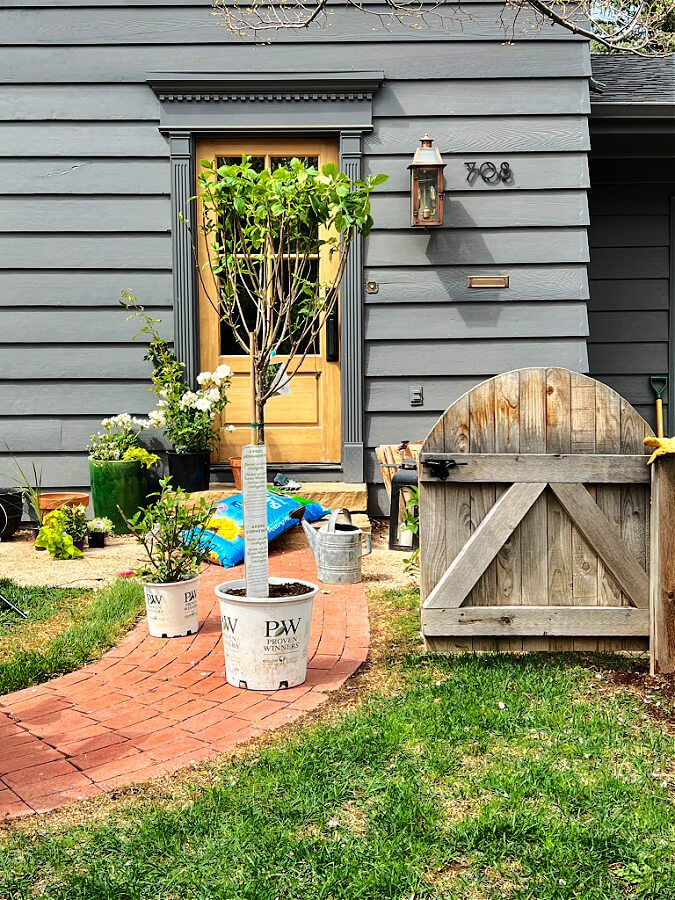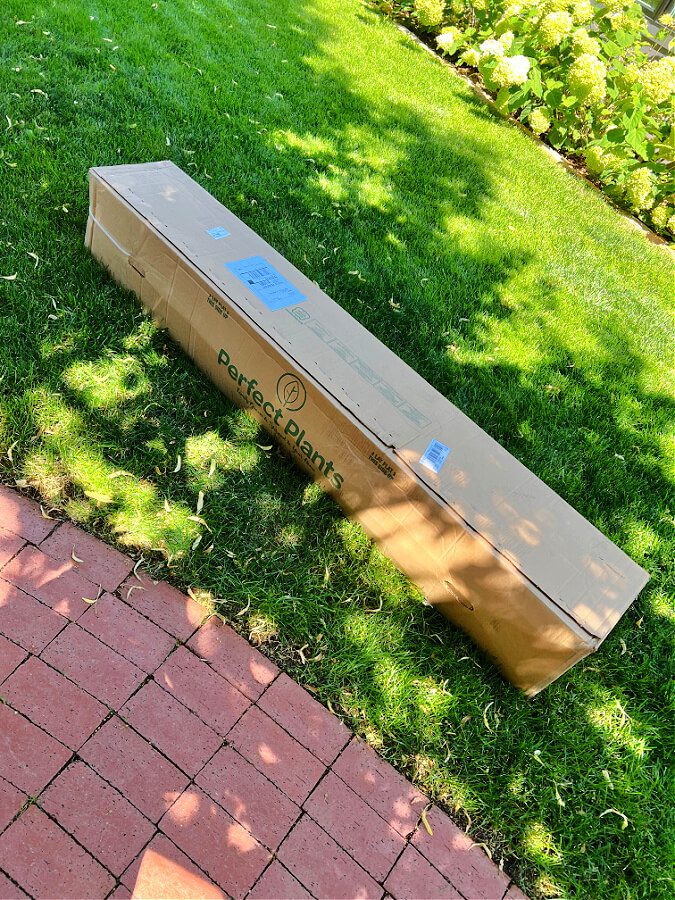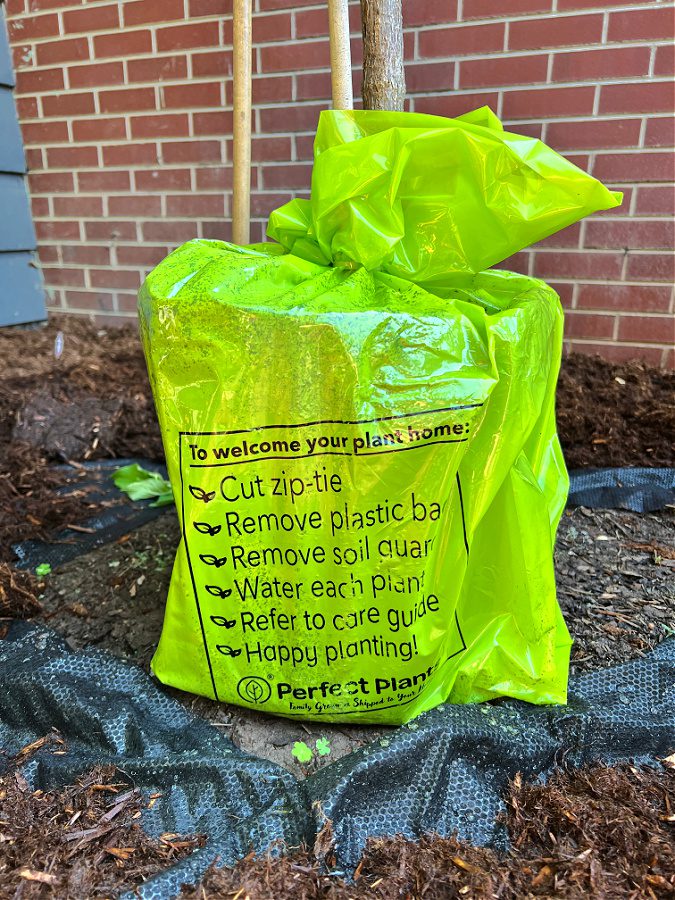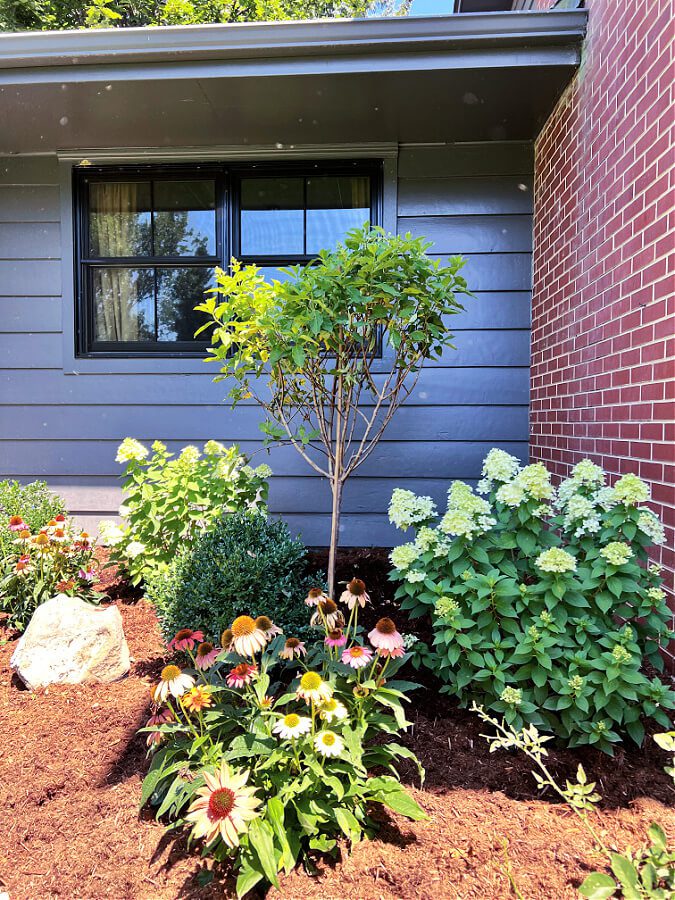My latest hydrangea crush is the Limelight hydrangea tree! Have you heard of or seen these lovely trees? These low maintenance plants produce beautiful and charming blooms that will leave you wanting more. Today’s post is all about the best tips for Limelight hydrangea trees.
This post contains some affiliate links for your convenience. Click here to read my full disclosure policy.
Just to be clear I am by no means a plant or garden expert. I just love getting my hands dirty and sharing what works for me in hopes that it will work for you too. I encourage you to do limelight hydrangea tree research like I did (mainly on google and Pinterest) to see how they will best work for you and your garden zone. We live in northern Colorado which is zone 5b, but these tips are very general and will work for all zones.
Limelight hydrangea trees are among the most stunning flowering shrubs for the home landscape. With their huge, cone-shaped blooms, they put on an unforgettable display of color in summer through fall. If you want a focal point that will grab attention, a Limelight hydrangea tree is hard to top.
Overview of Limelight Hydrangea Trees
Limelight hydrangea is a variety of panicle hydrangea (Hydrangea paniculata). It’s a deciduous shrub that is often grown in a tree form. The branches emerge from a straight trunk to create a small flowering tree.
Mature size is typically 8-10 feet tall with a 6-7 foot spread. The branches hold upright and don’t droop even after bloom.
Flowers emerge lime green in mid to late summer. They mature to creamy white before fading to pink and burgundy in fall. Flowers can reach 8-12 inches long!
Limelight hydrangea trees thrive in full sun in northern climates. In hot southern climates, afternoon shade is recommended.
They prefer moist, well-drained soil and have average water needs. Once established, they have some drought tolerance.
Pruning is easy! Just cut back by 1/3 each spring No special pruning is needed
Limelight hydrangea trees are hardy from zone 3-8. They bloom on new wood so winter dieback doesn’t affect bloom.
Why Grow a Limelight Hydrangea Tree?
Here are some of the best reasons to grow this showstopping flowering tree:
Unforgettable Flower Display
The huge, bold blooms on Limelight hydrangea trees always draw attention. Their colorful flowers stand out beautifully against the dark green foliage.
The blooms emerge chartreuse, fade to creamy white, then develop pink and burgundy tones in fall. This extended bloom period guarantees season-long color.
Easy Care
Limelight hydrangea trees have very low maintenance needs once established. All they require is moisture and annual pruning.
They are not bothered by pests or disease. Deer and rabbits leave them alone too thanks to their coarse texture.
Cold Hardy Performance
Limelight hydrangea trees thrive even in cold winter climates down to zone 3. Their flowers bloom on new wood so they rebloom faithfully each summer.
These carefree trees are ideal for northern gardeners who want summer flowers but hot, humid summers.
Versatile Landscaping Role
The upright, treelike shape of Limelight hydrangea makes it versatile to use in the landscape. It excels as:
- A flowering specimen or accent plant
- A tall privacy hedge or screen
- A colorful addition to shrub borders
- A focal point in island beds or planting beds
- A patio tree in planters and pots
Long-Lasting Bloom
Most flowering shrubs bloom for just a couple of weeks. But Limelight hydrangea trees offer months of flowers from summer through fall.
The blooms start out lime green in midsummer, then take on pink and burgundy hues in fall. Even after frost, they hold their dried blossoms for winter interest.
Easy Pruning
Panicle hydrangeas only need pruning once a year. Cut back the branches by 1/3 their length in late winter or early spring.
Occasional thinning is beneficial to open up the interior to light and air circulation. But Limelight hydrangeas rarely need corrective pruning.
Where to Buy Limelight Hydrangea Trees
Limelight hydrangea trees are sold at many garden centers and nurseries. But finding a healthy tree with a well-formed trunk can be hit or miss.
Buying Limelight hydrangea trees online from mail order nurseries offers a few advantages:
- Access to top-quality trees from professional growers
- Wider selection of tree sizes up to 7 gallons
- Ability to buy multiple matching trees
- Carefully grown and packaged trees
- Delivered fresh to your door at the ideal planting time
When selecting an online nursery, look for generous health guarantees and a proven reputation for excellent service.
Here are two recommended mail order sources for buying Limelight hydrangea trees online:
Wilson Bros Gardens
Wilson Bros Gardens offers Limelight hydrangea trees in #5 containers (4-5 feet tall). Their team carefully grows and packages each tree to arrive in excellent condition.
All trees come with a 1 year guarantee. Shipping is free within the continental U.S.
Proven Winners
Proven Winners sells their Limelight hydrangea trees through garden centers across the U.S. and Canada. Use their retailer locator tool to find a seller in your area.
Proven Winners provides detailed growing information on all their plants. Their plants are trialed under diverse conditions for consistent performance.
Planting and Caring for Limelight Hydrangea Trees
Here are some tips for successfully growing Limelight hydrangea trees:
-
Plant in spring or fall in a spot with full sun to part shade. Morning sun is ideal in hot climates.
-
Prepare a wide planting bed at least 2 feet in diameter. Improve drainage if needed.
-
Water regularly after planting and during the first year. After establishment, water during drought.
-
Apply mulch 2-4 inches deep to conserve moisture and suppress weeds. Avoid mounding mulch against the trunk.
-
Fertilize in early spring with a balanced fertilizer or rose food.
-
Prune annually in late winter. Cut back all branches by 1/3 their length to shape the plant and encourage new growth.
-
Protect from winter wind to avoid dieback. Situate the tree where it will be sheltered.
-
Remove spent flowers unless wanted for winter interest. Cut back to just above a bud.
With the right growing conditions, Limelight hydrangea trees will thrive for years of spectacular blooms. Their flowers transform the landscape into a showpiece from summer through fall.

Do Limelight Hydrangea Trees Need Full Sun?
Limelight hydrangeas need full sun depending on what zone your tree is planted in.
By rule of thumb if you are in a cooler hardiness zone such as zones 4-6, they will do best in 6 hours of direct sunlight.
But for zones 7-8, which tend to be more intense, they need partial sun to do best. This is where it is important for you to know your zone.

Where Can You Buy Limelight Hydrangea Trees?
I had a hard time finding limelight trees here around our town so I alwasy encourage you to call your local nursery first. I was able to find one in Denver over an hour away but I was also able to have one shipped to our front door from My Perfect Plants nursery!


They shipped me this incredible tree that we planted in our front yard . You can watch this video here of me unboxing it and planting it. So convenient and so easy. I lo e that I have two limelight hydrangea trees now!

Why Limelight Standard Hydrangea Trees are a Bad Idea
FAQ
What month do you plant limelight hydrangeas?
What do you think? A: Wait until late September to plant them in the ground. A bit of afternoon shade would be good, but they can take full sun all day long.Aug 9, 2019
How big will a limelight hydrangea tree get?
| Mature Height: | 6-8 ft. |
|---|---|
| Mature Width: | 4-5 ft. |
| Sunlight: | Partial Shade |
| Bloom Season(s): | Summer Blooming |
| Growth Rate: | Moderate Growing |
What is the best month to plant a hydrangea tree?
This timing will vary by region. For instance, in areas with winter freezing and snow, hydrangeas should be planted in early spring or early fall (as soon as summer heat breaks). In warmer regions with mild winters, the window for planting hydrangeas is longer, from fall all the way through to early spring.
Can a limelight hydrangea tree take full sun?
This extremely durable, long-lived plant is easy to grow. It likes full sun in cold climates, afternoon shade in warmer ones, but it does require well-drained soils that do not remain soggy for any amount of time.
